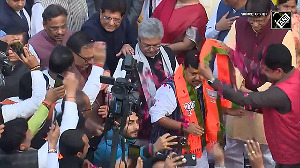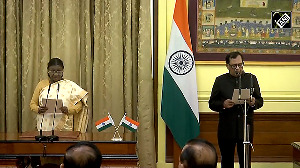As the festive season approaches, more and more desi families here in the US start to think in terms of entertaining and being entertained. Visions of Laddus, Burfis, Chaklis, sticky, decadent desserts and flashy party clothes start to swirl in people's minds.
Add to that the typical American holiday season with Thanksgiving, Christmas and New Year following on the heels of Diwali, and the joys and challenges of party planning take up a considerable portion of the last three months of the year.
What used to be a simple holiday get-together with perhaps a puja and one's favorite recipes served to family and friends has turned into something larger and more complicated now. More list making, more diplomacy, more recipe collecting and even hiring caterers have become the norm. Our lives have become busier, our soirees larger.
As more and more Indian Americans marry foreigners and/or adopt diverse lifestyles, one would assume our minds would open up wider and lead to more emancipated conversation and communication in a social gathering. However, in many instances I have noticed, the opposite is proving to be true. Diversification, while creating new and interesting topics of discussion, is also establishing new boundaries and gently enforcing fresh limitations.
Some years ago, the only situations requiring politically correct conduct were places of work or public areas like movie theaters and shopping centers. There was a time when Polish jokes, making fun of gay and obese people, and 'ridicule the Americans' sessions were quite widespread during desi get-togethers. Food could be as spicy or fat-laden as one chose and non-beef and non-pork dishes were the norm. Hindi movies, songs, and desi humor were welcome as additional entertainments at a party.
This is no longer true.
In recent years, the complexion of social gatherings has changed. We now invariably have people in the crowd who have spouses or significant others or friends who could be of any color, nationality, religion, sexual orientation, or political affiliation. Consequently, their children and grow up with dissimilar ideas, viewpoints and values. And we now have baby-boomers with health issues like diabetes, hypertension, prostate problems, arthritis, and medications that cannot be mixed with alcohol and certain foods, further complicating social life.
It seems every time someone opens their mouth to make a comment in a gathering, they have to look around to make sure their words will not hurt or insult someone in the room. Each time a party is planned, the host has to take into consideration the tastes, religious affiliations and health conditions of the guests.
Will the spicy chicken be intolerable to someone's German-American spouse? How about a non-sugar dessert for the diabetic guest? Should there be a no-salt version of the menu for the friend suffering from hypertension? Does so-and-so's Brahmin grandmother fast on Saturdays, and will she gag at the sight of lamb kebabs? Should the party be non-alcoholic to accommodate the gentleman who has joined Alcoholics Anonymous? Should the individual who insists on telling Sardarji jokes be omitted, since the other friend's son is now engaged to a Sikh girl? No fried Pakoras and Samosas since many of the guests have high cholesterol and some folks are perpetually on a diet? The list of restrictions gets more extensive as we grow older.
With the mix of cultures, tastes and opinions coming together so often, even prudent, politically correct individuals are finding social conversation a bit of a challenge. Most all of us have friends and relatives like the ones mentioned above and perhaps more. The permutation-combinations only appear to increase with each passing year.
But there are many positive aspects to the ever-changing face of the Indian-American social scene. When we desis immigrated to the United States, it was to become part of a culture that embraced variety and appreciated differences amongst people. To that end, we have discovered that America has more than delivered on its promise. Life has become more varied and interesting as a result of mixed marriages and the merging of religious, social, economic and political ideas. There is much to learn from others who are unlike ourselves and much to teach those who do not know all that much about us. Despite the expanding list of unmentionables, prohibitions and taboos, adapting to the new world kaleidoscope and appreciating its myriad shapes, sizes and colors is perhaps the key to a fruitful and fulfilling life experience.
Shobhan Bantwal's healthy party recipes:
Here are two high-protein, low-carbohydrate recipes ideal for the more health conscious guests.
Sugar-free Rasmalai
Makes 6 servings
Ingredients
2 cardamom pods
1 15-oz container ricotta cheese
1 16-oz container of half and half (soy milk may be used to reduce fat content)
1/2 cup plus 2 tablespoons Splenda (or to taste)
Method
Preheat the oven to 300 degrees.
Mix two tablespoons Splenda with the ricotta cheese until thoroughly blended. Spread the mixture in an 8 x 8 inch baking pan. Bake for 35 to 40 minutes or until the edges start to turn light golden in color. Set aside to cool.
Meanwhile, bring the half and half to a full rolling boil. Peel the cardamom, crush the seeds and add to the boiling half and half. Let it cool, then add the rest of the Splenda and stir.
Cut the cooled, baked cheese into 1-inch squares and pour the half and half mixture over it.
Quinoa Vegetable Pulau
Makes 4 to 6 servings.
Quinoa is pronounced kin-wah and is a protein-rich seed that grows in the Andean region of South America. It is widely used like a cereal and a low-carbohydrate, high protein, high-fiber substitute for rice and cream of wheat. In its natural form it has a bitter coating of what is known as saponins. But the processed variety sold in American health food stores has the coating removed, making it ready for use. The raw seeds look like large size poppy seeds or khus-khus, while the cooked version resembles tapioca or sabudana with a sickle-shaped edge on one side.
I make this kind of Pulau for my diabetic husband, who by the way, has switched to plain, cooked quinoa completely from his daily serving of white rice.
Ingredients
2 cups water
2 cloves garlic, minced
2 small sticks of cinnamon
2 cloves
2 tbsp corn or olive oil
2 tbsp grated coconut
2 tbsp chopped green coriander
1 cup diced carrots and cauliflower florets mixed (or any other combination of vegetables)
1 cup processed quinoa, rinsed and drained
1 medium onion, chopped
1 teaspoon grated ginger
1 green chilly, sliced
1 tsp lemon juice
Salt
Method
Heat the oil in a heavy-bottomed saucepan and saute the onion. Meanwhile, bring the water to boil with the salt and lemon juice in a separate pan. When the onion wilts and softens, add the garlic, ginger, hot pepper, cinnamon and cloves. Stir for 30 seconds. Toss in the quinoa and vegetables. Pour the boiling water into the pan and bring the mixture to a full boil. Reduce heat to very low, cover the saucepan with a tight lid and cook for 20 minutes. After turning off the heat, leave the lid on and do not stir for at least 15 minutes. This lets the quinoa bloom and plump up. Then stir gently to distribute the vegetables and grains evenly. Sprinkle grated coconut and chopped coriander before serving.
Shobhan Bantwal is a New Jersey, US-based writer whose first novel will be published in September next year. https://www.shobhanbantwal.com





